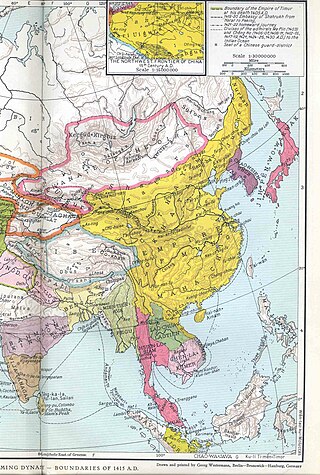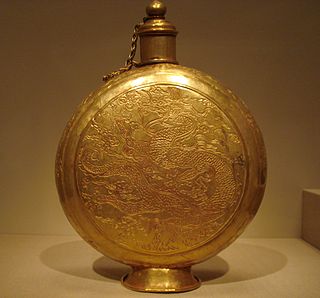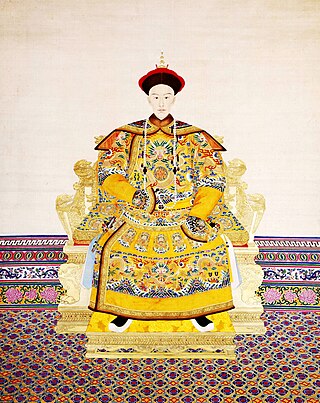
The Qing dynasty, officially the Great Qing, was a Manchu-led imperial dynasty of China and the last imperial dynasty in Chinese history. It emerged from the Later Jin dynasty founded by a Tungusic-speaking ethnic group who became known as the Manchus. The dynasty was officially proclaimed in 1636 in Mukden, and following the Battle of Shanhai Pass it seized control of Beijing in 1644, which is often considered the start of the dynasty's rule in China. Within decades the Qing had consolidated its control over the whole of China proper and Taiwan, and by the mid-18th century it had expanded its rule into Inner Asia. The dynasty lasted until 1912 when it was overthrown in the Xinhai Revolution. In Chinese historiography, the Qing dynasty was preceded by the Ming dynasty and succeeded by the Republic of China. The multiethnic Qing dynasty assembled the territorial base for modern China. It was the largest imperial dynasty in the history of China and in 1790 the fourth-largest empire in world history in terms of territorial size. With 419,264,000 citizens in 1907, it was the most populous country in the world at the time.

The Ming dynasty, officially the Great Ming, was an imperial dynasty of China, ruling from 1368 to 1644 following the collapse of the Mongol-led Yuan dynasty. The Ming dynasty was the last imperial dynasty of China ruled by the Han Chinese people, the majority ethnic group in China. Although the primary capital of Beijing fell in 1644 to a rebellion led by Li Zicheng, numerous rump regimes ruled by remnants of the Ming imperial family—collectively called the Southern Ming—survived until 1662.
The Haijin (海禁) or sea ban was a series of related isolationist policies in China restricting private maritime trading and coastal settlement during most of the Ming dynasty and early Qing dynasty. The policy introduced by the Ming founder Zhu Yuanzhang significantly hampered the growth of China's domestic trade, although the Ming was not able to enforce the policy in full despite official proclamations, and trade continued in forms like smuggling until the late Ming government opened the port of Yuegang for trade. Later, the early Qing dynasty's anti-insurgent "Great Clearance" (1661-1683) also caused considerable devastating effects on communities along the coast, until the Qing seized control of Taiwan and opened coastal ports to foreign trade.

The Shunzhi Emperor was the second emperor of the Qing dynasty of China, and the first Qing emperor to rule over China proper, reigning from 1644 to 1661. A committee of Manchu princes chose him to succeed his father, Hong Taiji (1592–1643), in September 1643, when he was five years old. The princes also appointed two co-regents: Dorgon (1612–1650), the 14th son of the Qing dynasty's founder Nurhaci (1559–1626), and Jirgalang (1599–1655), one of Nurhaci's nephews, both of whom were members of the Qing imperial clan.

The Wanli Emperor, also known by his temple name as the Emperor Shenzong of Ming, personal name Zhu Yijun, art name Yuzhai (禹齋), was the 14th emperor of the Ming dynasty, reigned from 1572 to 1620. "Wanli", the era name of his reign, literally means "ten thousand calendars". He was the third son of the Longqing Emperor. His reign of 48 years (1572–1620) was the longest among all the Ming dynasty emperors and it witnessed several successes in his early and middle reign, followed by the decline of the dynasty as the emperor withdrew from his active role in government around 1600.
The Battle of Jushi was a battle between the Han Dynasty and the Xiongnu for control of the people of the Jushi culture in the Turpan Basin in 67 BC. The battle was a success for the Han, who were led by Zheng Ji. The king of Jushi Wugui surrendered to the Han after the Han launched the attack from the Tarim Basin and besieged the city Jiaohe, capital of Jushi. The Xiongnu came with aid to Jushi, but escaped after Zheng Ji and Sima Xi confronted the armies. Zheng Ji then left 20 men with a general to protect the king of Jushi, but he was afraid of the return of Xiongnu, and fled to Wusun. The Xiongnu installed Doumo as the king of Jushi, and moved the population further east from Jiaohe. Zheng Ji then sent 300 men to seize the city.
The Southern Ming, also known in historiography as the Later Ming, officially the Great Ming, was an imperial dynasty of China and a series of rump states of the Ming dynasty that came into existence following the Jiashen Incident of 1644. Peasant rebels led by Li Zicheng who founded the short-lived Shun dynasty captured Beijing and the Chongzhen Emperor committed suicide. The Ming general Wu Sangui then opened the gates of the Shanhai Pass in the eastern section of the Great Wall to the Qing banners, in hope of using them to annihilate the Shun forces. Ming loyalists fled to Nanjing, where they enthroned Zhu Yousong as the Hongguang Emperor, marking the start of the Southern Ming. The Nanjing regime lasted until 1645, when Qing forces captured Nanjing. Zhu fled before the city fell, but was captured and executed shortly thereafter. Later figures continued to hold court in various southern Chinese cities, although the Qing considered them to be pretenders.

The Ming dynasty, officially the Great Ming, founded by the peasant rebel leader Zhu Yuanzhang, known as the Hongwu Emperor, was an imperial dynasty of China. It was the successor to the Yuan dynasty and the predecessor of the short-lived Shun dynasty, which was in turn succeeded by the Qing dynasty. At its height, the Ming dynasty had a population of 160 million people, while some assert the population could actually have been as large as 200 million.

The economy of the Ming dynasty (1368–1644) of China was one of the largest in the world during that period. It is regarded as one of China's three major golden ages. The period was marked by the increasing political influence of the merchants, the gradual weakening of imperial rule, and technological advances.

The economic history of China covers thousands of years and the region has undergone alternating cycles of prosperity and decline. China, for the last two millennia, was one of the world's largest and most advanced economies. Economic historians usually divide China's history into three periods: the pre-imperial era before the rise of the Qin; the early imperial era from the Qin to the rise of the Song ; and the late imperial era, from the Song to the fall of the Qing.
Japanese missions to Ming China represent a lens for examining and evaluating the relationships between China and Japan in the 15th through the 17th centuries. The nature of these bilateral contacts encompassed political and ceremonial acknowledgment as well as cultural exchanges. The evolution of diplomatic ties accompanied the growing commercial ties which grew over time.
Kenchū Keimitsu (堅中圭密) was a Japanese Zen Buddhist monk and diplomat in the Muromachi period. He was the chief envoy of a mission sent by the Ashikaga shogunate to the court of the Yongle Emperor in Nanjing. He would return to China at the head of four subsequent missions to the Chinese Imperial court in Beijing.
The Discourses on Salt and Iron was a debate held at the imperial court in 81 BCE on state policy during the Han dynasty in China. The previous emperor, Emperor Wu, had reversed the laissez-faire policies of his predecessors and imposed a wide variety of state interventions, such as creating monopolies on China's salt and iron enterprises, price stabilization schemes, and taxes on capital. These actions sparked a fierce debate as to the policies of the Emperor. After his death, during the reign of Emperor Zhao of Han, the regent Huo Guang called on all the scholars of the empire to come to the capital, Chang'an, to debate the government's economic policies.

During the Manchu–led Qing dynasty, the economy was significantly developed and markets continued to expand especially in the High Qing era, and imperial China experienced a second commercial revolution in the economic history of China from the mid-16th century to the end of the 18th century. But akin to the other major non-European powers around the world at that time like the Islamic gunpowder empires and Tokugawa Japan, such an economy development did not keep pace with the economies of European countries in the Industrial Revolution occurring by the early 19th century, which resulted in a dramatic change described by the 19th-century Qing official Li Hongzhang as "the biggest change in more than three thousand years" (三千年未有之大變局).

Salt, salt production, and salt taxes played key roles in Chinese history, economic development, and relations between state and society. The lure of salt profits led to technological innovation and new ways to organize capital. Debate over government salt policies brought forth conflicting attitudes toward the nature of government, private wealth, the relation between the rich and the poor, while the administration of these salt policies was a practical test of a government's competence.

The China men's national volleyball team represents China in international volleyball competitions and friendly matches, governed by Chinese Volleyball Association. The team competed twice in the Olympic Games, finishing in eighth place at the 1984 Summer Olympics in Los Angeles, California, and fifth place in the 2008 Summer Olympics at home in Beijing. China have been consistently competing the FIVB World Championship, with a best of seventh place in both 1978 and 1982. On a continental level, China won three gold medals at the Asian Games, in 1986, 1990 and 1998. China also won 3 gold medals at the Asian Championship in 1979, 1997 and 1999. The team now ranks 26th in the FIVB World Rankings and the current head coach is Wu Sheng.
Sun Yuanhua, also known as Ignatius Sun, was a Chinese mandarin under the late Ming. A Catholic convert, he was a protégé of Paul Xu. Like his mentor, he advocated repelling the Manchu invasion by modernizing Chinese weaponry and wrote treatises on geometry and military science influenced by the Jesuits' European knowledge. From 1630 to 1632, he served as governor of Denglai, a Ming district around Dengzhou and Laizhou in northern Shandong. He was deposed by the mutiny of Kong Youde and Geng Zhongming, after which he was arrested and executed by the Ming for having failed to crush their rebellion with sufficient severity.
Zhu Changxun (1586–1641) was the third son of the Ming dynasty Wanli Emperor. His mother, Noble Consort Zheng, was a favoured concubine and, in efforts to please her, the emperor attempted to have Zhu made heir apparent, but failed to overturn the rule of primogeniture. After the fall of the Ming, however, Zhu's son, Zhu Yousong, became emperor of the Southern Ming dynasty.

The Hubu Guanpiao is the name of two series of banknotes produced by the Qing dynasty, the first series was known as the Chaoguan (鈔官) and was introduced under the Shunzhi Emperor during the Qing conquest of the Ming dynasty but was quickly abandoned after this war ended, it was introduced amid residual ethnic Han resistance to the Manchu invaders. It was produced on a small scale, amounting to 120,000 strings of cash coins annually, and only lasted between 1651 and 1661. After the death of the Shunzhi Emperor in the year 1661, calls for resumption of banknote issuance weakened, although they never completely disappeared.











